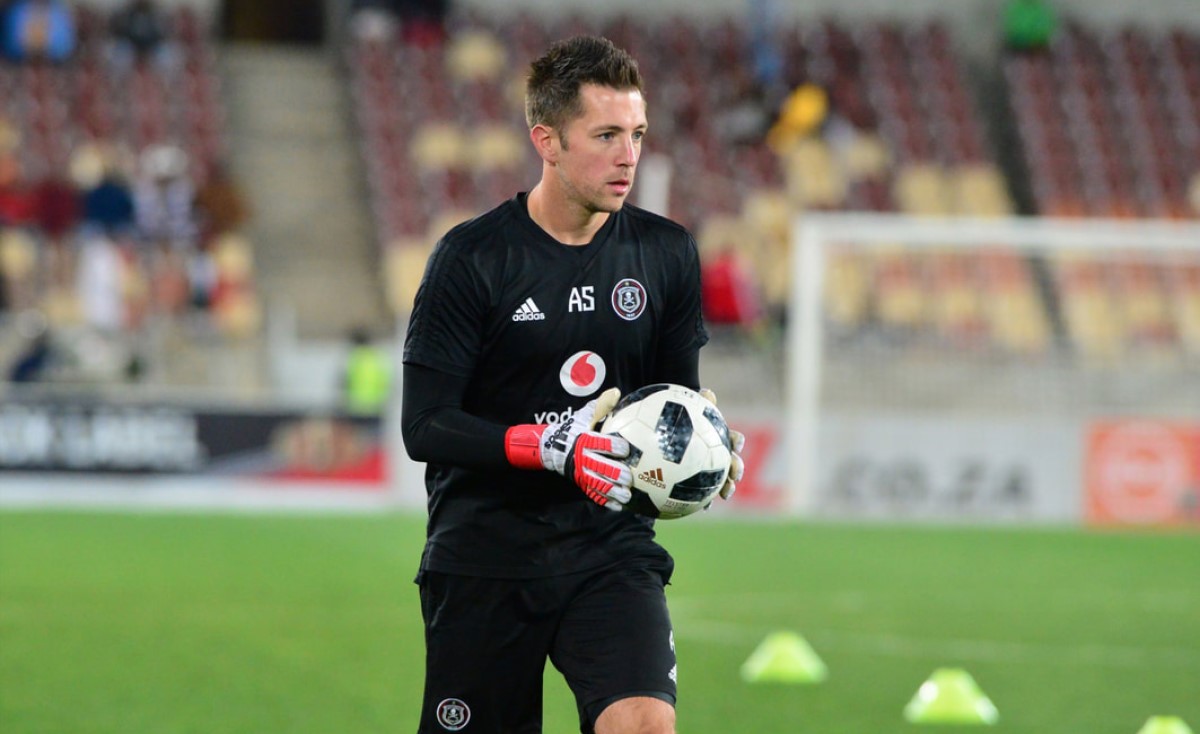




OUR BEST EVER OFFER - SAVE £100/$100
JOIN THE WORLD'S LEADING PROFESSIONAL DEVELOPMENT PROGRAMME
- 12 months membership of Elite Soccer
- Print copy of Elite Player & Coach Development
- Print copy of The Training Ground
You are viewing 1 of your 1 free articles
Shot stopping for keepers
This is a functional shot stopping session that starts using just the goalkeepers and the goalkeeping coach and it then progresses into a broader session and a small-sided game with the outfield players.
| Area | Up to 54x44 yards |
| Equipment | Balls, bibs, cones, 3 mannequins, 2 full size goals |
| No. of Players | 10 players + up to 3 goalkeepers |
| Session Time |
Shot stopping 1: 10mins, Shot stopping 2: 10mins, Shot stopping 3: 20mins, 3v2 Shot stopping: 20mins, 5v5 Game: 20mins |
This is a functional shot stopping session that starts using just the goalkeepers and the goalkeeping coach and it then progresses into a broader session and a small-sided game with the outfield players.
The integration of the outfield players makes the session more match realistic and it will enhance the goalkeeper’s decision making in game situations by reading and understanding different cues, such as his position in relation to the area of the pitch, the threat to goal, and the recovering defenders.
It develops the relationship between the goalkeeper and his defenders, whilst also working on the attacking players’ approach to creating goal scoring opportunities.
This session needs to be well planned with the outfield coaches to integrate the goalkeepers and the players successfully. The outfield coaches can coach the attacking players, while the goalkeeping coach can coach the defenders and goalkeepers.
What do I get the players to do?
We start by running a warm-up [not shown] with the goalkeeper performing specific movements, such as movement into line and across the goal, as well as the kind of technical actions needed within the session. After the warm-up, the goalkeeper will be put through a series of different shot stopping exercises, which will also transfer into situations that occur later in the session…
Shot stopping 1
We set up in the penalty area with a full size goal and with two mannequins representing defenders. In addition to the goalkeeper, we’re using two servers, which can be the other goalkeepers. Server 1 starts with the ball on the edge of the penalty area and passes into the keeper, who plays a return pass. Server 1 receives and then passes to Server 2, who sets up the goalkeeping coach for a shot, as shown [1].
1
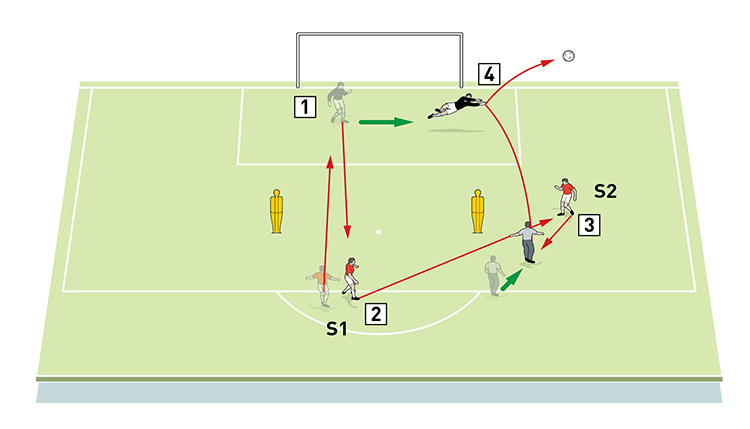
2. Server 1 receives and plays the ball to Server 2
3. Server 2 sets up the coach for a shot. The coach must strike into the keeper’s hands or force him into a low or medium dive
4. The goalkeeper must adjust his position into line with the ball
The goalkeeper must adjust his position into line with the ball, and the coach can strike into the keeper’s hands, or force him to make either a low dive or a medium dive. We play this for 10 minutes.
Shot stopping 2
We use the same set up as before and the coach starts by playing a bounce pass with the goalkeeper. When he receives the return pass, the coach can either shoot directly at goal, or he can pass to one of the servers positioned on either side of him. The servers can either shoot first time, take a touch and shoot, or go 1v1 with the keeper, as shown [2]. We play this for 10 minutes.
2

2. The keeper adjusts his position depending on the movement of the ball
3. The server can either shoot first time or take a touch and shoot
4. To keep it varied, the server can also go 1v1 with the keeper
Shot stopping 3
Using the same set up as before, we add a third mannequin on the edge of the penalty area. The goalkeeper starts play with a one-two with Server 1, before passing out to Server 2. When he receives the ball, Server 2 lays off to the coach, who can shoot first time, as shown [3], or play the ball back to either of the servers to shoot. On receiving a pass from the coach, Server 2 also has the option of playing the ball back for Server 1 to try a shot from outside the penalty area. We play this for 20 minutes.
3
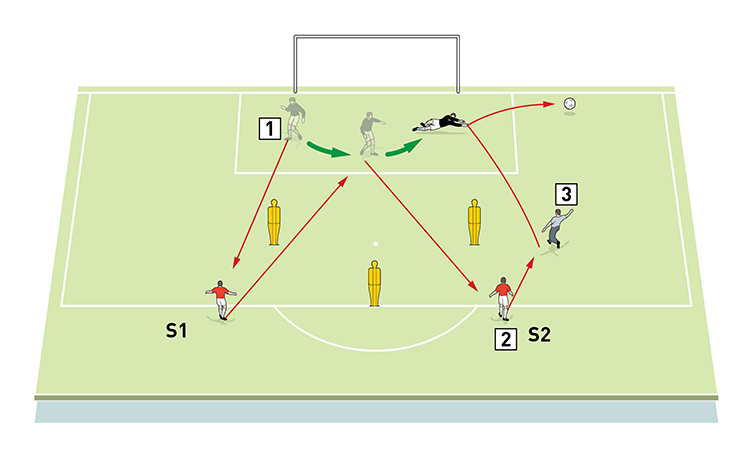
2. Server 2 receives the ball and lays it off to the coach
3. Here the coach shoots first time, but he can also play back to either server to shoot, while Server 2 also has the option to pass the ball on to Server 1 for a shot from outside the area
How do I progress the session?
3v2 Shot stopping
We next run a functional session with the goalkeeper now integrated with the outfield players to face a 3v2 attack on goal. This practice will expose keepers to the different kinds of situations they will have to defend against with their team mates.
We set up an area the size of two penalty boxes (36x44 yards), with a goal and goalkeeper at one end. We’re using 10 outfield players, split into six attackers (blues) and four central defenders (reds). The attackers start at the far end of the pitch in two waves of three, and two defenders wait at each side of the pitch near the halfway point.
Play starts with one of the defenders, who knocks the ball to the goalkeeper. The keeper then plays a one-two with a centre back on the other side of the pitch, before playing a lofted pass to one of the waiting attackers at the far end, as shown [4a]. Two defenders then move quickly into a central position, ready to defend against the first wave of attackers. The attackers have a 3v2 overload and must combine to create a goal scoring opportunity, as shown [4b].
4a
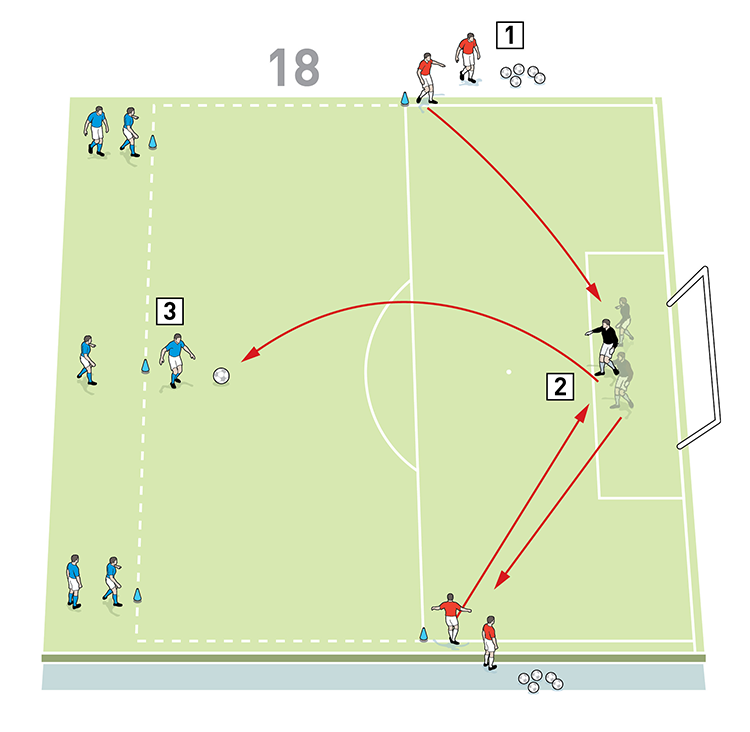
2. The keeper then plays a one-two with the waiting defender on the other side of the pitch, before hitting a lofted pass up the pitch to the attackers
3. On receiving the ball, the first wave of three attackers can launch an attack on the goal
4b
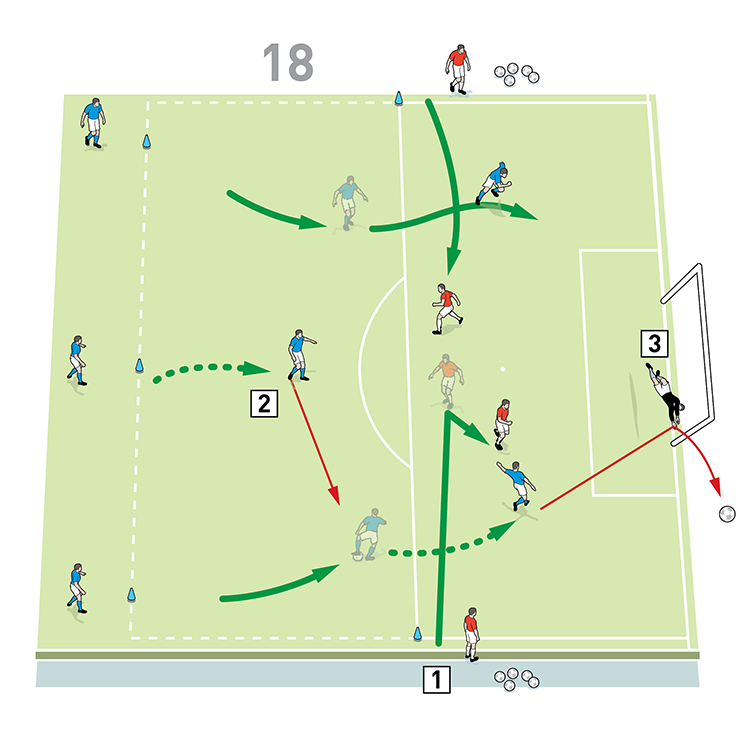
2. The attackers look to combine and score in the goal for a point
3. If the defenders win possession, or if the keeper makes a save, the defending team scores a point
If the attackers score a goal they get a point, but if the defenders win possession and clear the ball out of the area, or if the goalkeeper makes a save, the defending team is awarded a point.
Once the ball is dead, the cycle repeats with the next wave of attackers and defenders. We play this for 20 minutes.
How would you put this into a game situation?
5v5 Game
We finish the session with a small-sided game that is used to expose the goalkeepers to realistic shot-stopping situations in a game format.
We set up an area of 54x44 yards – the size of a penalty box at each end separated by an 18-yard central zone. We position a full size goal and a goalkeeper at each.
We’re using 10 outfield players split into two teams of five. Each team starts with three attacking players in the central zone and two defenders in their defensive third. One goalkeeper starts play by making a lofted pass down the pitch to the opposite keeper, and on the first touch of the receiving keeper one of the opposing players from the middle third can leave their zone and press the ball, as shown [5].
5
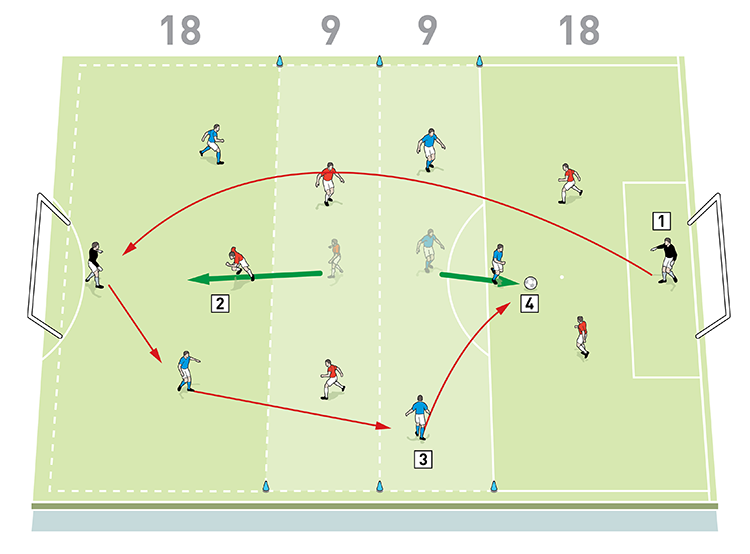
2. On the first touch of the receiving keeper, one of the red attackers from the middle third can leave his zone and press the ball
3. The keeper plays out to a team mate and the blues combine to launch an attack
4. An attacker can enter the final third to shoot only once the ball has been played into the zone
The team in possession must get the ball to their three attacking players in the middle zone to start a 3v2 attack on the opposition goal. An attacker can enter the final third to take a shot as long as the ball has been passed into the zone first.
If a goal is scored, or if the ball goes dead, restarts are from the keeper. We alternate ends for each restart. We play this for 20 minutes.
What are the key things to look for?
In the early part of the session, where decision making is limited, we will look for the goalkeepers to improve on the actions that are specific to keepers. Once the outfield players are integrated into the practice, the goalkeeper’s focus will be on more tactical aspects, such as reading the game. The latter activities will put the keepers in decision-making situations, where good communication and a strong relationship with the defenders will also be developed.
What are the typical mistakes players might make, and how do I avoid them?
It is a mistake to work with the keepers in isolation too much. The goalkeeping coach must work closely with the outfield coaches to ensure that the keepers are integrated into the team session as much as possible. This will instil strong decision-making qualities into a goalkeeper’s game, an aspect they won’t normally be able to develop when the keepers work purely in isolation.
Related Files
Editor's Picks
Attacking transitions
Deep runs in the final third
Using the goalkeeper in build-up play
Intensive boxes drill with goals
Penetrating the final third
Creating and finishing
My philosophy
Pressing initiation
Compact team movement
Coaches' Testimonials

Alan Pardew

Arsène Wenger

Brendan Rodgers

Carlos Carvalhal

José Mourinho

Jürgen Klopp

Pep Guardiola

Roy Hodgson

Sir Alex Ferguson

Steven Gerrard
Coaches' Testimonials

Gerald Kearney, Downtown Las Vegas Soccer Club

Paul Butler, Florida, USA

Rick Shields, Springboro, USA

Tony Green, Pierrefonds Titans, Quebec, Canada
Join the world's leading coaches and managers and discover for yourself one of the best kept secrets in coaching. No other training tool on the planet is written or read by the calibre of names you’ll find in Elite Soccer.
In a recent survey 92% of subscribers said Elite Soccer makes them more confident, 89% said it makes them a more effective coach and 91% said it makes them more inspired.
Get Monthly Inspiration
All the latest techniques and approaches
Since 2010 Elite Soccer has given subscribers exclusive insight into the training ground practices of the world’s best coaches. Published in partnership with the League Managers Association we have unparalleled access to the leading lights in the English leagues, as well as a host of international managers.
Elite Soccer exclusively features sessions written by the coaches themselves. There are no observed sessions and no sessions “in the style of”, just first-hand advice delivered direct to you from the coach.
